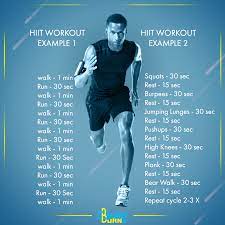I. Introduction
Definition of High-Intensity Interval Training (HIIT)
High-Intensity Interval Training, commonly known as HIIT, is a workout strategy alternating short periods of intense exercise with brief periods of rest or lower-intensity activity.
Growing Popularity of HIIT
In recent years, HIIT has gained immense popularity due to its efficiency and effectiveness in achieving fitness goals.
II. Science Behind HIIT
Metabolic Impact
HIIT is renowned for its ability to boost metabolism, leading to increased calorie burn even after the workout.
EPOC (Excess Post-Exercise Oxygen Consumption)
The phenomenon of EPOC ensures that the body continues to burn calories post-HIIT, contributing to weight loss.
III. Physical Benefits of HIIT
Cardiovascular Health
HIIT significantly improves cardiovascular health, enhancing heart function and reducing the risk of heart diseases.
Weight Loss and Fat Burning
The intensity of HIIT accelerates fat loss, making it an ideal choice for those aiming to shed excess weight.
Muscle Building and Toning
Contrary to the misconception that HIIT only focuses on cardio, it is an excellent tool for muscle building and toning.
IV. Mental Benefits of HIIT
Improved Mood and Stress Reduction
HIIT triggers the release of endorphins, promoting a positive mood and reducing stress levels.
Cognitive Function Enhancement
Research suggests that HIIT can enhance cognitive functions, including memory and focus.
V. Time Efficiency of HIIT
Short Workouts with Significant Impact
HIIT workouts are known for their brevity while delivering significant results, making them suitable for busy individuals.
Adaptability to Busy Schedules
The flexibility of HIIT allows individuals to tailor workouts to fit even the tightest schedules.
VI. HIIT for All Fitness Levels
Scalability and Adaptation
HIIT can be scaled to accommodate various fitness levels, from beginners to advanced athletes.
Safety Considerations
Proper form and gradual progression are crucial to ensuring safety during HIIT sessions.
VII. Structuring an Effective HIIT Workout
Warm-up and Cool-down Importance
A thorough warm-up and cool-down are vital components of a successful and safe HIIT workout.
Sample HIIT Workout Routine
An example HIIT workout routine can guide beginners and provide variety for seasoned enthusiasts.
VIII. Common Misconceptions about HIIT
Belief in the Need for Prolonged Workouts
Dispelling the myth that effective workouts must be lengthy, HIIT offers efficiency in a shorter time frame.
Potential Risks and Safety Concerns
Addressing concerns about injuries by emphasizing the importance of proper technique and progression.
IX. Personalized Approach to HIIT
Tailoring Workouts to Individual Fitness Goals
Customizing HIIT workouts ensures alignment with personal fitness objectives.
Consultation with Fitness Professionals
Seeking guidance from fitness professionals can enhance the effectiveness and safety of HIIT.
X. Success Stories and Testimonials
Real-life Experiences of Individuals
Exploring success stories showcases the transformative power of HIIT in people’s lives.
Transformation Narratives
Hearing about the journeys of individuals who embraced HIIT can inspire and motivate readers.
XI. Integrating HIIT into Daily Life
Incorporating HIIT into Busy Schedules
Providing practical tips on seamlessly integrating HIIT into daily routines.
Making HIIT a Habit
Establishing HIIT as a consistent habit for long-term health and fitness benefits.
XII. HIIT and Technology
Fitness Apps and Wearables
Utilizing technology to enhance the HIIT experience, including app recommendations and wearable devices.
Virtual Classes and Online Resources
Accessing HIIT workouts virtually, making it convenient for individuals to exercise anytime, anywhere.
XIII. Dietary Considerations with HIIT
Importance of Balanced Nutrition
Highlighting the role of nutrition in maximizing the benefits of HIIT and supporting overall health.
Hydration and Recovery
Emphasizing the significance of proper hydration and recovery strategies in conjunction with HIIT.
XIV. Long-term Health Benefits
Preventive Impact on Chronic Diseases
Examining how HIIT contributes to the prevention of chronic diseases, promoting holistic well-being.
Aging Gracefully with HIIT
Discussing how HIIT can support aging individuals in maintaining vitality and strength.
XV. Conclusion
Recap of HIIT Benefits
Summarizing the diverse benefits of HIIT for both physical and mental well-being.
Encouragement for Readers to Try HIIT
Inspiring readers to embark on their HIIT journey and experience the transformative effects.
Frequently Asked Questions (FAQs)
Is HIIT suitable for beginners?
- Yes, HIIT can be adapted to various fitness levels, including beginners. It’s important to start gradually and consult with a fitness professional if needed.
How often should I do HIIT workouts?
- The frequency of HIIT workouts depends on individual fitness goals. Starting with 2-3 sessions per week and adjusting based on personal preferences and recovery is recommended.
Are there any age restrictions for HIIT?
- HIIT can be modified for different age groups. However, individuals with pre-existing health conditions should consult with a healthcare professional before starting HIIT.
Can I do HIIT at home without equipment?
- Absolutely! Many HIIT workouts can be done using bodyweight exercises at home. However, incorporating some equipment, if available, can add variety.
What is the best time to do HIIT workouts?
- The best time to do HIIT is when it fits into your schedule and when you feel most energized. Some prefer mornings for a boost, while others choose evenings for stress relief.

